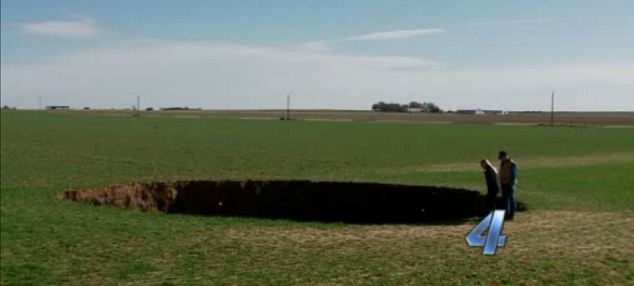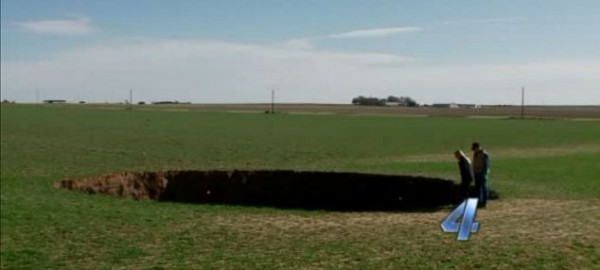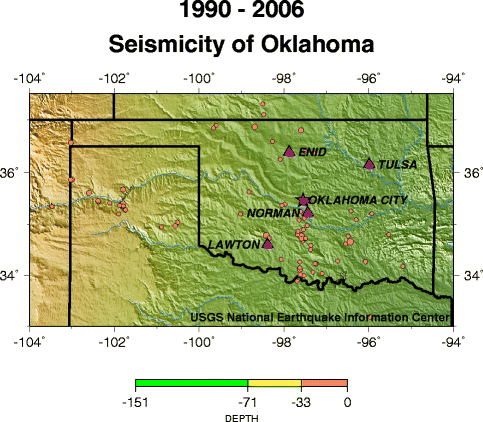Massive sinkhole opens up in Sayre, Oklahoma

A massive sinkhole appears overnight at Beckham County near Sayre, Oklahoma. KFOR reports that the sinkhole is about 40 feet deep and 40 feet wide. Sinkholes are not so uncommon in western Oklahoma. Geologists at the Oklahoma Geological Survey say several things could have caused the sinkhole including salt or rock formations dissolving or a drought. They also say old coal mines are often full of water and when that water drains, there is no support causing the soil above it to collapse.
See video and read the original story at KFOR.com

For those wondering why it is so round: this is a common geometry for these type of “cover-collapse” sinkholes, also called “dropout” sinkholes. Fine-grained sediment often has enough cohesion that it will hold itself together. When a void develops, the sediment that collapses into the void will form a soil arch, resembling a dome in 3-dimensions. This is a stable geometry and will hold up the walls of the void, much like an arch holds up walls of a building over a doorway. The hole will progressively grow upward over time, but will maintain its arch-like cross section, until it ultimately breaks the surface and we see a circular hole.
An earthquake connection?


A string of small earthquakes have been rattling Oklahoma over the past month and residents are wondering if the natural disasters are to blame for an emerging sinkhole. This sinkhole formed just two days after Oklahoma’s last earthquake about two weeks ago. And the shaking has continued since then. There have been a string of small quakes over the past week; the strongest was a 3.7 on Thanksgiving. There was a 2.7 on Tuesday morning. On 5 November an earthquake measuring 5.6 rattled Oklahoma and was felt as far away as Illinois. Until two years ago Oklahoma typically had about 50 earthquakes a year, but in 2010, 1,047 quakes shook the state. In Lincoln County, where most of this past weekend’s seismic incidents were centered, there are 181 injection wells, according to Matt Skinner, an official from the Oklahoma Corporation Commission, the agency which oversees oil and gas production in the state. The practice of injecting water into deep rock formations causes earthquakes, both the U.S. Army and the U.S. Geological Survey have concluded.


The Meers fault located in south-central Oklahoma, about 100 km southwest of Oklahoma City, is the only fault identified in the state with evidence of surface-rupturing earthquakes in the last 3000 years (prior to historical settlement of the region). Paleoseismology studies have identified a temporal clustering of a least three earthquakes on this fault, two of which are dated (1200-2900 years before present) and the third is believed to be older in age.
While large earthquakes are not common in Oklahoma, according to a geological survey report of Oklahoma by Kenneth V. Luza, there have been more than 880 earthquakes in the Anadarko Basin between 1897 and 2002. The Anadarko Basin is a geological feature that covers nearly 50,000 square miles. Most of the basin is located in the west-central part of Oklahoma. Most of the earthquakes that occur in Oklahoma are not felt due to being of magnitudes of between 1.8 and 2.5. There have been earthquakes in 72 counties of Oklahoma. The only counties that have never reported an earthquake are Adair, Craig, Jackson, Nowata and Washington.
It could even be the depleted aquifer underground. Without the water pressure to support the upper layers, it can cause the upper layers to weaken and fall.
There is a reported new Sink Holes south of Snowflake Arizona.
Picher, Oklahoma sinkhole


looks like the hole in the ice in Russia from the Feb 15th meteorite